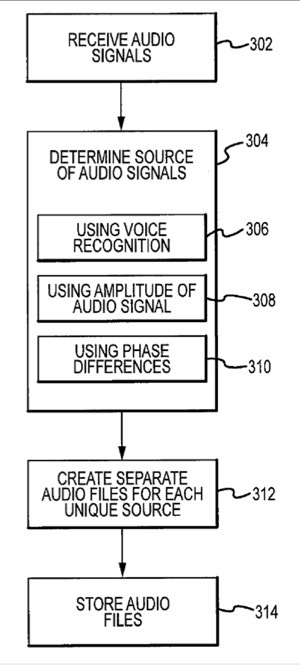An Apple patent (number 20110161074) for a remote conferencing center has appeared at the US Patent & Trademark Office. It relates generally to audio and/or video recording and, more specifically, to determining sources of audio signals for audio and/or video recordings.
Certain embodiments disclosed herein relate to systems and methods for recording audio and video. In particular, in one embodiment, a method of recording audio signals is provided. The method includes recording audio signals with a plurality of distributed audio transducers to create multiple recordings of the audio signals and providing each of the multiple recordings of the audio signals to a computing device.
The computing device combines each of the multiple recordings into a master recording and determines a source for each audio signal in the master recording. Additionally, the computing device stores each audio signal in separate audio files according to the determined source of each audio signal. Aleksandar Pance and Nicholas Vincent King are the inventors.
Here’s Apple’s background and summary of the invention: “Audio and video recordings are some of the most reliable ways of preserving contents of a conversation, lecture or discussion. However, frequently, even with the benefit of video, it may be difficult to determine the source of a particular statement or question.
“The difficulty of identification is increased for people who were not present or involved in the conversation, lecture or discussion, when viewing or listening to the recording. Even for those who were involved in the discussion, the passage of time generally dims the memory to make discerning such information difficult.
“Generally, devices for generating recordings and/or transcripts include a consolidated device that may have multiple speakers and microphones. However, in larger environments, speakers who are too far removed from the consolidated device do are not detected or not detected to a discernible degree, resulting in an unintelligible recording.
“Additionally, the recordings are typically stored as a single indexed file, making searching for content from a particular source (e.g., participant such as a lecturer or student) difficult.
“Certain aspects of embodiments disclosed herein by way of example are summarized below. It should be understood that these aspects are presented merely to provide the reader with a brief summary of certain forms an invention disclosed and/or claimed herein might take and that these aspects are not intended to limit the scope of any invention disclosed and/or claimed herein. Indeed, any embodiment disclosed and/or claimed herein may encompass a variety of aspects that may not be set forth below.
“In one embodiment, a method of recording audio signals is disclosed. The method includes recording audio signals with a plurality of distributed audio transducers to create multiple recordings of the audio signals and providing each of the multiple recordings of the audio signals to a computing device. The computing device combines each of the multiple recordings into a master recording and determines a source for each audio signal in the master recording. Additionally, each audio signal is stored in a separate audio file according to the determined source of each audio signal.
“In another embodiment, a method of managing audio signals from multiple sources is disclosed. The method includes determining an identity for a plurality of unique sources of recorded audio signals and sorting the recorded audio signals according to the determined identities. Additionally, the audio signals are stored in separate audio files according to the sorting.
“In yet another embodiment, an audio recording system is disclosed. The audio recording system includes plurality of distributed sound transducers and one or more processors coupled to the plurality of sound transducers. A storage device is coupled to the one or more processors. The one or more processors is configured to determine a source for received audio signals, aggregate received audio signals according to the determined source, and store the aggregated audio signals as separate audio files in the storage device according to the determined source.”
— Dennis Sellers



